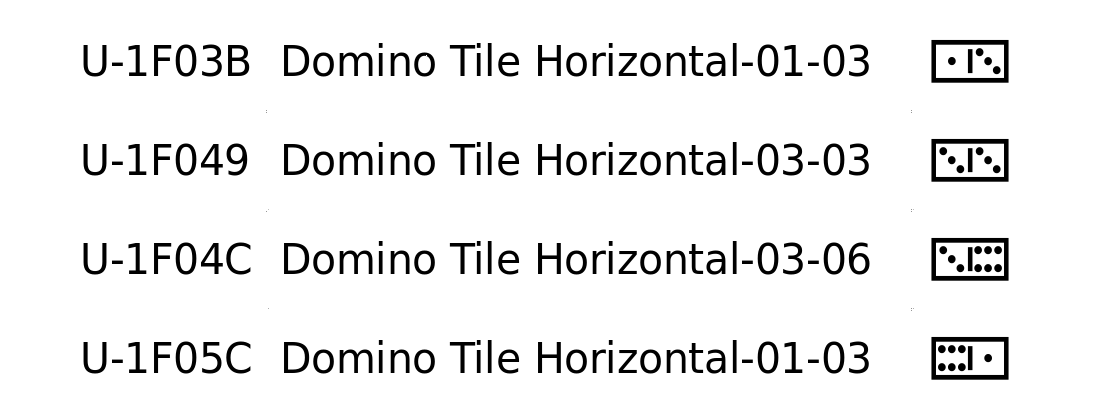The Puzzling Quirks of Regular Expressions
- Acknowledgments
- Rights of (Wo)Man
- Credits
- Preface
- Quantifiers and Special Sub-Patterns
- Pitfalls and Sand in the Gears
- Creating Functions using Regexen
- Easy, Difficult, and Impossible Tasks

The Puzzling Quirks of Regular Expressions

Support the author!
Lulu Editions
Paypal Donation
Other Publications
Dominoes is an old family of games dating at least from the Yuan Dynasty (around 1300 CE). The game is played with tiles on which each half of one side is marked, generally with a number of dots corresponding to a number. Specific games vary in their rules, but most require matching the symbol or number on half of a tile with the corresponding symbol on another tile.
There are, in fact, Unicode characters for all the domino tiles that have zero to six dots on each half. We will come back to those characters in the next puzzle. As a reminder, some of those Unicode characters are listed in this table.

The actual codepoints are hard to enter, and hard to see unless they are displayed at a large font size (as here). But to illustrate the “game” our regex will play, we can show examples of, first, a valid/winning pattern:

And second, an invalid/losing pattern:

In this game, tiles are placed in linear order, and two may occur adjacently only if they have the same number of dots where they “touch.” Unlike with physical tiles, these symbols may not be turned around, but maintain the same left-right order.
Because of the display and entry problems mentioned, we play an alternative version of this game in which “tiles” are spelled as ASCII characters. For example, the winning and losing patterns shown as Unicode characters are as follows in their ASCII versions:
# Winning
{1:3}{3:3}{3:6}{6:1}{1:3}{3:3}{3:3}
# Losing
{1:3}{3:3}{6:1}{1:3}{3:3}{3:6}{3:3}Plays may be of any length. Infinitely many tiles, with ends having the numbers 1-6 in every combination, are available. Write a regular expression that distinguishes every winning play from a losing play. Note that any character sequence that doesn’t define a series of one or more tiles is trivially losing.
Before you turn the page…
You might do this more efficiently than your first thought.
Because of our ASCII encoding we have a shortcut available for the regular expression that can judge whether a play is winning. This would not be available with the icon characters for the domino tiles.
The same digit must occur at the end of one tile, and again at the start of the next tile. Therefore, we can shortcut specifically matching ’3’s with ’3’s and ’5’s with ’5’s. Instead, we can just use a lookahead to match a backreference group.
# Mismatched ends in bad, malformed syntax in awful
>>> good = '{1:3}{3:3}{3:6}{6:1}{1:3}{3:3}{3:3}'
>>> bad = '{1:3}{3:3}{6:1}{1:3}{3:3}{3:6}{3:3}'
>>> awful = '{1:3}{{3:5}}{5:2}'
>>> pat = r'^(({[1-6]:([1-6])})(?=$|{\3))+$'
>>> for play in (good, bad, awful):
... match = re.search(pat, play)
... if match:
... print(match.group(), "wins!")
... else:
... print(play, "loses!")
...{1:3}{3:3}{3:6}{6:1}{1:3}{3:3}{3:3} wins!
{1:3}{3:3}{6:1}{1:3}{3:3}{3:6}{3:3} loses!
{1:3}{{3:5}}{5:2} loses!